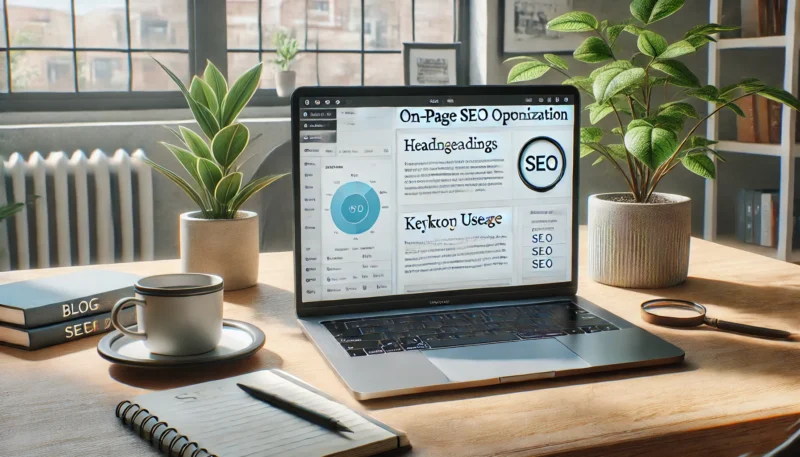If you’re just starting out in SEO, mastering on-page optimization is one of the smartest moves you can make. Unlike off-page tactics that depend on backlinks or external signals, on-page SEO is fully in your control — and it has a direct impact on how search engines understand and rank your content.
In this guide, you’ll learn 10 practical, beginner-friendly tips to improve your website’s visibility and user experience.
1. Use One H1 Tag with a Clear Keyword Focus
Each page or post on your website should have only one H1 tag, which typically serves as the page title. This tag tells search engines (and users) what your content is about.
Tip: Include your target keyword in the H1 naturally. For example:
✅ “How to Start a Blog in 2025”
🚫 “Welcome to My Awesome Page”
2. Optimize Title Tags and Meta Descriptions
These two elements appear in search results and play a big role in click-through rate (CTR). Your title tag should be concise and include your main keyword, while your meta description should briefly explain what the page offers.
Example:
-
Title: 10 Easy On-Page SEO Tips for Beginners
-
Meta Description: Learn simple and effective SEO strategies to improve your website rankings and attract more organic traffic in 2025.
3. Use Proper Heading Structure (H1, H2, H3…)
Search engines and readers love well-organized content. Use headings to divide your content into sections.
-
H1: Main title of the page (only once)
-
H2: Main section titles
-
H3: Subsections under H2
-
H4–H6: Rarely needed, but can be used for extra nesting
This structure makes your content easier to scan and improves accessibility.
4. Focus on Keyword Placement
Place your main keyword in strategic spots:
-
First 100 words of the content
-
H1 and at least one H2 heading
-
Image ALT texts
-
URL slug (e.g.,
/on-page-seo-tips) -
Meta title and description
But avoid keyword stuffing — always write naturally for the reader.
5. Optimize for Mobile Devices
Google uses mobile-first indexing, meaning it primarily uses the mobile version of your site to rank content. Your site must:
-
Be fully responsive
-
Have buttons and menus that are easy to tap
-
Load quickly on mobile networks
-
Avoid content or pop-ups that block the screen
Test your site using Google’s Mobile-Friendly Test tool.
6. Use Internal Linking Strategically
Linking to other relevant pages within your website helps:
-
Distribute link authority
-
Improve crawlability
-
Keep visitors engaged for longer
Use descriptive anchor text — not just “click here” — to provide context.
Example:
👉 Instead of click here, say learn more about keyword research for SEO.
7. Improve Page Speed
Slow-loading pages lead to high bounce rates and lower rankings. Improve your site speed by:
-
Compressing images without losing quality
-
Minimizing CSS, JavaScript, and HTML files
-
Using browser caching and a CDN (Content Delivery Network)
-
Hosting on a fast and reliable server
Use tools like PageSpeed Insights or GTmetrix to test and improve performance.
8. Write for Humans First, Search Engines Second
Google is smarter than ever. In 2025, SEO isn’t about tricking algorithms — it’s about serving your audience better than anyone else.
-
Write in a clear, engaging tone
-
Use short paragraphs and bullet points
-
Anticipate reader questions and answer them
-
Include real examples, stats, or case studies
Helpful content gets shared and ranked — plain and simple.
9. Add Image ALT Text and Compress Media
Search engines can’t “see” images the way humans do. That’s where ALT text comes in — it describes what the image is about.
ALT text helps with:
-
SEO (when it includes relevant keywords)
-
Accessibility (screen readers rely on it)
-
Image search rankings
Also, compress your images before uploading them to reduce page load time.
10. Create Clean, SEO-Friendly URLs
Short, descriptive URLs are easier to remember and better for SEO. Avoid long, random strings or unnecessary parameters.
Good example:
✅ /seo-tips-for-beginners
Bad example:
🚫 /post?id=2341&ref=homepage
Best practice: Use hyphens to separate words and keep it lowercase.
Final Thoughts: On-Page SEO Is the Foundation of Visibility
If you want to grow your organic traffic, start with what’s in your control: your own pages.
On-page SEO doesn’t require fancy tools or a huge budget. All it takes is attention to detail, a bit of practice, and a focus on delivering value to your audience.
By applying these 10 tips consistently, you’ll set a solid foundation for future growth — and give your content a real chance to shine in the search results.

